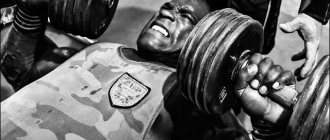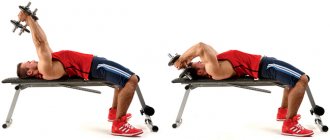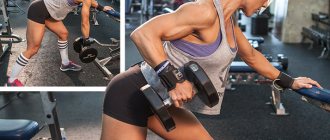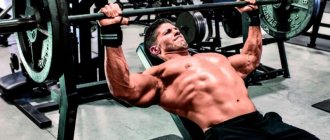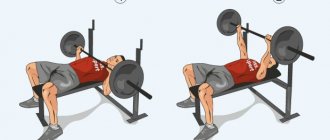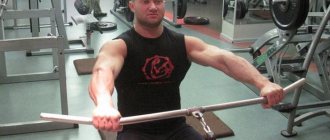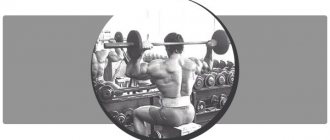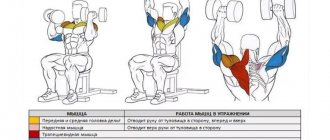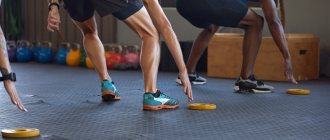Home / Exercises for muscle development / Guillotine exercise
In this article, I will tell you about the guillotine exercise, which is aimed at growing chest muscles.
The guillotine exercise is considered the best exercise (from the point of view of electrical myostimulation) aimed at developing (growth) of the chest muscles.
It is considered the best because it best concentrates the load on all three bundles of the pectoral muscles, because for those who don’t know, the chest muscles are conventionally divided into three bundles: up, middle and bottom. See photo:
There are a huge number of different exercises for developing the chest muscles, in particular, this or that bundle. Well, for example, it is believed that for the development of the upper chest, the best work is inclined upside-down barbell/dumbbell presses; for the lower chest, horizontal bench presses, parallel bars, etc.
And this is indeed true. Various exercises (in our case, on the chest muscles) = develop different bundles of pectoral muscles. But today's guillotine exercise is unique.
Unique in the sense that when various exercises were tested for the development of chest muscles = using electrical myostimulation = this exercise showed the best results (indicators) involving all 3 bundles of chest muscles:
- For the development of the upper chest, the exercise that was slightly in the lead was the dumbbell press on an incline bench. Compared to the guillotine. Still, the other various exercises were far behind.
- For the development of the middle and lower chest = the guillotine tore everyone. Leading exercise!
I have been using this exercise in my training practice for a long time = which I recommend that you start too (if you have not already started), because benefits according to research (measurements were made of the electrical activity of muscles during work - this is an indicator of the intensity of muscle contraction, on the basis of which a conclusion is made about which exercise is effective/less effective, etc.) - speak for themselves: 302 up the pectoral muscles, 511 - middle of the chest, 502 - bottom of the chest. For example, a regular bench press showed: 198 up chest, 288 middle chest, 345 down =)
The rest of the exercises, like the regular bench press, are far from the Guillotine. Hence we can conclude that the guillotine exercise is the BEST exercise for developing the pectoral muscles!
Load
To understand how more effective “Guillotine” is than the basic execution, you should familiarize yourself with the results of electromyography performed for the same purpose. The essence of the study is to measure the electrical activity of muscle groups during exercise, the results of which can be used to draw a conclusion about the effectiveness of the work done in the gym.
Thus, the basic bench press turns out to be the most useless, since it loads the chest only in the following ways:
- top – 198;
- middle – 288;
- bottom – 345.
From here it is immediately clear why the majority of athletes who lift weights have a noticeably more developed lower chest. The load of the exercise goes almost entirely to the bottom and involves the top to a minimum.
In the “Guillotine” style, the barbell press demonstrates completely different activity indicators. The top of the chest receives a load of 302 units, the bottom - 502, and the middle - 511. With such research results, we can safely say that this exercise is almost 2 times more effective than the basic one. At the same time, the load on the middle and bottom of the chest is almost the same, which means they will develop together without noticeable differences. Even the upper muscles, which receive noticeably less load in the “Guillotine” exercise, work in it almost the same way as the lower ones in the basic bench press, and there this is the maximum limit! Based on this, there is no point in arguing about the effectiveness of the work done; the main thing is to do it correctly.
Guillotine style bench press. Exercise for the pectoral muscles
The Guillotine style bench press is the best exercise for targeting all three pectoral muscle bundles. This is a unique exercise that few people have heard of, and even fewer who know how to do it correctly. The “Guillotine” exercise for the pectoral muscles is significantly more effective than the classic bench press, dumbbell press, as well as all kinds of flyes. Try this exercise in your workouts, and you will immediately feel how much your pecs are involved in the work.
Why is the bench press not the best exercise for the pectoral muscles?
The bench press is a popular, basic exercise that shows the strength of the entire shoulder girdle. One of the three triathlon exercises in powerlifting. Depending on the technique of execution, it may involve a different number of muscles. In gyms you can see 3 types of bench press techniques:
- Elevator style
(shake as much as possible). With this style of execution, the barbell is lowered to the bottom of the chest, the legs are rested on the floor, and a “bridge” is used. All this leads to a decrease in the range of motion, partial removal of the load from the pectoral muscles and the inclusion of the back and legs in the work.
- Close to elevator operator
(middle option). The feet are on the floor, but there is no “bridge”; the barbell drops to the bottom of the chest. The amplitude is greater than in the lifter style. In general, not fish, not meat. Due to the lack of specialization, this type of bench press is not suitable for developing strength or pumping up the pectoral muscles.
- Bodybuilding press
(pumping the pectoral muscles). The bar is lowered closer to the head, the legs are on the bench or raised up and bent at the knees. This type of press increases the range of motion and stretches the pectoral muscles more strongly, including them in the work as much as possible.
But based on data from Bret Contreras' experiment with electromyography (EMG). Electromyography is a measurement of the electrical activity of muscles during exercise. It turned out that the pectoral muscles are most involved in the work when performing the “guillotine” exercise (302 - up, 511 - middle, 502 - bottom). And the pectoral muscles work worst of all when performing regular bench presses (close to the lifter’s in the list above) (198 - up, 288 - middle, 345 - bottom). As can be seen from the results of electromyography, the classic bench press loads the lower pectoral muscles the most, because of this, benchers have the best developed lower chest, but the upper and middle of the pectoral muscles are poorly pumped.
Guillotine style bench press
The exercise is not new at all. It was extremely popular in the 60-70s of the last century (the golden era of bodybuilding). The Guillotine style bench press was invented by Vince Gironda, one of the greatest bodybuilding trainers of all time. While experimenting with bench presses, he noticed that if you lower the barbell to the neck, closer to the chin, the load on the pectoral muscles becomes greater.
Exercise for the pectoral muscles “guillotine”: technique of execution
For success in bodybuilding, proper exercise technique is as important as nutrition for gaining muscle mass. When performing this type of bench press, you must adhere to 3 recommendations:
- The barbell is lowered onto the neck, as close to the chin as possible. This leads to greater stretching of the pectoral muscles by lengthening the amplitude.
- To reduce stress on the triceps and increase stretch in the pecs, use a wide grip.
- To isolate the work of the pectoral muscles, place your feet on a bench or lift them up, bending your knees. This technique eliminates the “bridge”.
Useful feature:
To feel the work of the pectoral muscles even better, try performing the exercise with your eyes closed, fully concentrating on muscle contraction + do not straighten your elbows to the end (press at the bottom of the amplitude).
Cautions:
- Use only a closed grip. If the barbell falls on your neck from an open grip, this will have sad consequences.
- Perform the exercise at a moderate and slow pace. At the bottom of the press, the pectoral muscles are stretched quite a lot, so if you press in an explosive style, the risk of injury increases.
- Don’t try to set strength records by doing the exercise 1-3 times. This may cause injury due to the reason stated in the previous paragraph.
Breast
History of appearance
If one of the young people training in the gym has just learned about this exercise, then this is only his miscalculation. The Guillotine bench press style appeared back in the distant “golden era” of bodybuilding. One of the most famous trainers at that time was Vince Gironda, who invented this exercise through lengthy experiments on his own body.
Vince wanted to learn absolutely every technique to perform the exercise in order to maximize the effectiveness of his training. Thanks to his fanaticism, today all bodybuilders know the possibility of maximizing the development of the pectoral muscles. To do this, the bar should be lowered closer to the neck, making the work more difficult for the chest. It was its approach to the throat that became the reason for such a creepy name, because if the barbell is poorly fixed and dropped directly on your neck, the result will be disastrous.
Basic technique
To master the Guillotine exercise, you must first understand the basic technique. The main problem for most beginners is that the bench press is performed incorrectly or incorrectly. In the latter case, this indicates the correct technique, but not for the goals that the athlete faces. It often happens that a novice bodybuilder does everything as expected, but the muscles do not grow. The problem here is that different correct techniques are aimed at radically different results. You can press a barbell this way to increase muscle mass or increase endurance, that is, lift more weight.
Load by muscle group
Old exercises are not always worse than new ones.
Gaining muscle mass with modern machines is no easier than with outdated dumbbells and barbells. Time passes, new technologies appear, but simple basic exercises, as they were the best for muscle growth, remain so. But today I want to talk not about the usual basic movements that we are all accustomed to, but about the old and undeservedly forgotten presses, deadlifts and squats of the Golden Era of bodybuilding. Introduction
Watching videos filmed during the training of bodybuilding stars, I notice that many of them use exercises of old strongmen, invented 50-60-70 years ago. This is a little strange, since professional athletes who have made bodybuilding their business must use only the most advanced training techniques and the most effective exercises for muscle growth.
Why, then, does Kai Greene perform Jefferson squats in every leg workout, and fitness star Steve Cook actively pumps his biceps while doing barbell lifts using the Vince Gironda method? Perhaps they know that some old exercises are much more effective than new ones, or maybe it’s just that bodybuilding is returning to its roots?
Guillotine press
This version of the barbell chest press, like many other non-standard exercises of the old school, was invented by a great trainer, bodybuilder, writer, businessman and just a bodybuilding fan named Vincent Anselmo Gironda.
Vincent Gironda | Author of many effective weight training exercises
He trained the most famous bodybuilders of the time: Larry Scott, Sergio Oliva and even Arnold Schwarzenegger himself. And Hollywood film studios paid him for preparing fat big-screen stars for filming in the next film masterpiece. Clint Eastwood, Cher, Kurt Russell and Denzel Washington trained in his gym.
Read more: Pullover with a dumbbell: correct technique, working muscles
But the point is not even the magnitude of his coaching talent, but the fact that the guillotine press, an old exercise for the chest, is being used again by professional bodybuilders. And this is not surprising, because, according to scientific research conducted in 2010, the guillotine bench press suddenly turned out to be one of the best exercises for the pectoral muscles.
When performing such an exercise, a much larger array of muscle fibers is involved in the work than with a classic bench press. And most importantly, the guillotine barbell press affects not only the bottom, but also the top of the chest, which makes it doubly effective. This one differs from the usual classic version in that:
- The bar of the bar rests on the neck (hence the name), rather than on the undercut of the chest. This allows you to engage the upper segment of the pectoral muscles.
- Hands are spread as wide as possible. This provides additional stretch to the pecs as you lower the bar.
- Feet are on a bench (alternatively, raised and bent at the knees). This achieves a higher degree of isolation of the pectoral muscles, since the back is tightly pressed to the bench and the legs are turned off from work.
Forgotten mass exercises |
Guillotine bench press The guillotine bench press is a very effective exercise for gaining mass, although it is not easy and requires additional safety measures. I perform it exclusively in a power rack with the movement limiters set. I really like it, and I use it every other chest workout for mass, alternating with dumbbell presses.
Conclusion: the guillotine barbell press is much more complex than the classic version, but more effective, especially for increasing muscle mass in the upper chest.
The second most important section after the top of the pectoral muscles is their middle. If you analyze the chest training programs of bodybuilding stars, it becomes clear that they attach incredibly great importance to this small muscle segment.
The developed middle visually adds volume to the chest, making it stronger and wider. The guillotine press adds overall muscle mass to the pectoral with an emphasis on the upper segment, and the Svend press actively affects its middle.
This exercise was invented by our contemporary, Norwegian strongman, powerlifter, and later bodybuilder Svend Odegaard Carlsen, a public favorite, remembered for shouting loudly: “Viking strength!” before you grab the barbell.
Svend Odegaard Carlsen | Author: Svend's press
This added color and Scandinavian charm to him, especially since Svend always showed phenomenal strength results. Bench press – 270 kg x 2 times, squat – 400 kg, deadlift – 430 kg. After an injury, he retired from the sport and now works on Norwegian television as a producer and host of a strongman show.
Read more: How to run properly in winter to avoid getting sick 10 tips
Lifting weights
To increase your performance in lifting weights, the technique should be selected with maximum muscle unloading. The easier it is for them to work, the more the athlete will be able to take. By the way, this is the technique that is most often found in gyms. They call it the elevator operator.
The main task is to transfer as much load as possible from the chest to other muscles. To do this, you need to arch your back into a “bridge,” thereby reducing the amplitude of the barbell stroke. Lowering the projectile to the bottom of the chest also gives a similar result. During this exercise, your legs rest on the floor, which allows you to control your back.
Something in between
Barbell chest exercises can immediately train your endurance and help you gain mass. To do this, the technique described above is slightly modernized, making the arch in the back less pronounced. At the same time, the bar also lowers to the bottom of the chest, but due to the smaller “bridge” the load on the chest increases.
Professional bodybuilders do not recognize this technique at all, and it can only be found in amateur gyms. The fact is that the exercise does not have a clear focus, which means that the result will be poor in terms of gaining mass and increasing the weight lifted.
Bench Press Variations
Depending on the range of motion of the barbell, the position of the bench and the athlete on it, there are many types of bench press.
Classic bench press
The classic bench press is performed in a horizontal position on a bench. The initial position of the barbell is on outstretched arms, after which it is lowered with the bar onto the chest and, after a short pause, returns to its original position. There is an alternative option for performing this exercise, when the bar takes its initial position on the stops in the frame at the level of the athlete’s chest, and then from this position it is pressed up until the arms are completely aligned and returns to the stops again.
The press, in which the legs, unlike the classic one, are not on the floor, but are pressed against the body on a bench press, is excellent for those who have problems with the spine due to strong deflection during the exercise according to the classical scheme.
The so-called “touch” press is performed similarly to the classical technique, only the pause during which the bar touches the chest should be as short as possible. However, competitive technique in powerlifting involves squeezing the barbell up only after a command that allows it to be done.
The rack press reduces the range of motion of the barbell using limiters that are installed at the level of the athlete's chest in the power rack. This training option is convenient in cases where the athlete is just recovering from an injury or when there is no partner nearby who can back up.
There are a class of exercises on an inclined bench, including:
- The incline bench press most uses the upper part of the pectoral muscle, in this case it is the execution technique that plays a big role, not the weight of the barbell. At the same time, the greater the angle of inclination of the bench, the more load falls on the anterior deltoid muscles;
- Bench press with an incline strengthens the lower part of the pectoral muscle; to achieve maximum effect, it is advisable to straighten your arms as much as possible at the top point, however, this exercise is quite dangerous, so it is better to use insurance, and for those who suffer from increased intracranial or intraocular pressure or have problems with cardiovascular -vascular system, it is better to avoid this exercise altogether;
The reverse grip press mostly loads the top of the pectoral muscle and the shoulder joint, while removing the barbell from the racks on your own is quite inconvenient and dangerous, so it is better to perform this exercise with a safety net.
The advantage of bench pressing with dumbbells instead of a barbell is that in this exercise the apparatus can be lowered much lower, which allows you to use the muscles being trained to a greater extent.
The bench press with a back arch due to the decrease in the trajectory of the barbell allows you to take on more weight, while the load is redistributed to the lower chest. This exercise is not recommended for those who have back problems.
Pressing on a Smith machine is relatively safe due to the fact that the bar moves vertically in the frame, but the development of some strength indicators during such training remains incomplete.
The close-grip press improves the shape and size of the triceps, and also engages the triceps, deltoids, and upper pectoral muscles. The distance between the fingers when gripping the bar directly in this exercise should be no more than 40 cm.
The wide grip press is often used in powerlifting to train the chest push.
This exercise is characterized by a small range of motion of the stay due to its close proximity to the chest, but this allows for greater weight and greater emphasis on working the pectoral muscles, rather than the triceps, as with a close-grip bench press. This exercise is effective for chest and shoulder growth.
The French press is recommended to be performed using a curved barbell in order to remove the stress from the forearm. This exercise is aimed at developing the triceps. It is performed with a narrow grip, but at the same time the bar of the barbell is lowered not to the chest, but to the head. In this case, the legs should rest solely on the floor, and not on the bench, so as not to lose balance and avoid injury.
Pumping up muscles
Now it’s time to talk in detail about the “Guillotine” exercise. It is this pressing technique that makes the work of the chest muscles as difficult as possible and allows you to maximize their size. To perform a bodybuilding bench press, arching in the back should be completely eliminated so that all the load goes to the chest. To do this, the feet should be placed on a bench, closer to the buttocks, or even raised up, keeping the legs bent at the knees.
It is necessary to lower the projectile closer to the neck, which increases the amplitude of the barbell stroke and increases muscle stretching.
Performance nuances
To increase the load on the muscles to the maximum, you should work with the projectile only within the amplitude. Simply put, you cannot fully extend your elbows while lifting the barbell. For safety, only a wide grip should be used in this exercise. This will take the pressure off your triceps and help you maintain balance. Also, a wide grip will allow you to stretch your pectoral muscles more, and therefore accelerate their growth.
Reviews of the Guillotine exercise from professionals also indicate the use of only a closed grip to protect yourself when lifting medium weights. The thumb should form a ring around the bar along with the rest and lie between the ring and index fingers.
It is the increased load on the muscles being worked in bodybuilding that accelerates the growth of muscle mass. If you simplify the work of your body, the result will be completely different. Endurance, strength and speed of work will increase, but the mass will remain the same.
Exercise options
Now let's move directly to the bench press variations. There are quite a lot of them, and they all have their own characteristics.
Classic bench press - how to perform the program correctly
Of course, you should start with the most standard method of execution. It is performed on a horizontal bench with a free barbell with a medium grip.
- We load the bar with the required number of weights and lie down on the bench.
- The bar should be at eye level. Naturally, you need to lie straight so that the bar does not become distorted.
- The shoulder blades, shoulders and buttocks should lie tightly on the bench, maintaining a natural deflection in the lower back.
- We place our legs tightly on the entire foot on the sides of the bench.
- Place your hands on the bar with a medium grip, that is, your palms should be slightly wider than your shoulders (photo). An average grip looks something like this:
There are marks on the fingerboard that you can use to guide you. Ask them to show you clearly how to take wide, narrow or medium
- In this case, we place our hands so that our palms face in the direction of our legs.
- As you exhale, you need to lift the barbell from the racks and bring it above your chest with straight arms, this will be the starting position.
- From this point, inhale and slowly lower the bar, bending your elbows to the middle or bottom of your chest.
- In this case, we almost touch the barbell to the chest, but do not lower it down.
- As you exhale, press the projectile up.
We’ll master the classic version first, but if you want progress, you need to try different variations of the exercise.
All other options are technically performed similarly, but have their own nuances, which we will analyze.
Press with touch
Unlike the previous version, where we noted that we bring the barbell almost to contact with the chest, in this case we touch the chest.
Do not place the barbell in such a way as to remove the load from the muscles, do not pause
It is important here that the moment of contact is as short as possible: just touch and immediately forcefully press the barbell up, that is, the exercise is performed without pauses. This allows you to develop explosive power, which will improve your benching performance and can also be useful for martial arts athletes.
The exercise can be performed in any variation, with any grip and with any inclination.
Power Rack Press for Beginners
If it is not possible to resort to the help of a belayer, you can perform the exercise in a frame. At the same time, unlike Smith, you continue to work with free weight, that is, controlling the trajectory using the muscles, nothing limits you. But if you suddenly lose control or are unable to press the barbell, you can throw it and it will fall onto the racks without crushing you.
This is a very good option when recovering from an injury or lacking a partner for insurance. In other variants, such a press only harms
In addition, the frame controls the range of motion. This can be both a minus and a plus. If you have had an injury that does not allow you to put too much strain on your muscles, ligaments, or joints, this is a great option for you. But otherwise, you are simply depriving yourself of work in a wide amplitude, which will affect the speed of progress.
Bench angle
Once you've mastered the flat bench press, it makes sense to try it on an incline. Why is it important? Most likely, like most athletes, you have a lagging chest area. For some it’s the bottom, for others it’s the top, and for others, it’s unlucky with the inside. If you change the angle, you will be able to more thoroughly work the desired area of the pectoral muscles.
Positive slope
If you need to more thoroughly work the upper bundles of the pectoralis major muscle, namely they give the visual effect of a large inflated chest and are difficult to engage in a horizontal bench press, you need to resort to a press with a positive incline.
To work the top bun more effectively, you should use a bench with a positive incline
The higher the slope, the more the upper muscles are activated. But you need to start with a slight slope, about 15 degrees. Subsequently, it needs to be increased to 25–30, rarely to 45.
This inclination option is optimal, the load does not go to the deltoids or triceps
If the degree of inclination is increased too much, then you will work the deltoids much more than the pecs.
If the bench is not adjustable and is fixed at this incline, it is better to find an adjustable bench and lower it lower
Negative slope
If you want to target your lower chest muscles more, you can use a downward incline bench. It is easier to perform bench presses in a negative incline. However, this exercise cannot be done with heavy weight.
In addition, it is forbidden to do the incline press if you have problems with ICP, blood pressure, dizziness and migraines.
You can try making a very small slope - up to 15 degrees. This is not so dangerous, and if you feel well and have no contraindications, you can periodically try this exercise option.
But doing bench presses with an incline of 30 degrees or more is highly undesirable.
Video: Head down press
Option “guillotine” - a technique to increase breast size
As you may have noticed, changing the angle of inclination is quite inconvenient or technically difficult, moreover, you can only influence one area of the chest. The “guillotine” exercise makes it possible to actively connect all three beams, while it is performed on a horizontal bench.
In the classic version, we lower the barbell to the middle or bottom of the chest, but in this case we need to bring the bar to the neck. This, of course, is quite dangerous, so the exercise cannot be performed without a spotter, but if you do the bench press correctly, you will pump up all three bundles of the pectoral muscles well.
In addition, you should take the barbell with a slightly wider grip than the classic one, which will allow you to stretch your chest muscles well when lowering.
A great exercise for working your chest muscles, but make sure you do it as safely as possible!
When you lower the barbell to the neck area, you arch your lower back more than usual, which is not good. This moment needs to be controlled. Some people place their feet on a bench or hold them in the air, as in a crunch. This option is quite risky because you must be sure that you have good control over your movements.
Overall, this exercise is for advanced athletes, otherwise you may lose balance or control at some point during the exercise.
Video: Guillotine press
Machine press - Smith machine
The Smith machine is an excellent option for beginners and for those who are practicing their technique, since the bar is securely fixed in the frame and only moves along a certain trajectory.
The Smith machine is an ideal option for practicing exercise technique
It turns out that the bar only moves up and down, and you do not need to try to keep it from “walking” back and forth. Accordingly, this partially facilitates and slightly isolates the exercise.
In addition, you can perform the bench press without a spotter, because if you feel that you won’t be able to press it, you can hook the barbell to the nearest loops.
The bar in Smith is equipped with hooks and, if necessary, you can fix it at any height
You can use different angles, grips and exercise techniques. And unlike a frame, you are not limited in the vertical range of motion.
Reverse Grip Press
The classic bench press is performed with a direct grip, but you can also try a reverse one.
Keep in mind that if you drop the barbell with this option, it will land on your face and can seriously injure you.
What does this option provide?
- You can work your upper pectoral muscles without using an incline bench.
- The triceps quite strongly “steal” the load from the pectoral muscles in the horizontal press, but in this case this does not happen: both muscles are equally intensively involved in the work.
- With a narrow arm position, you do not have to make sure that your elbows do not diverge to the sides.
Video: Reverse Grip Press
Narrow and wide hand placement
We've already talked a little about different grips. In this vein, it is important to pay attention to the width of the hands on the bar. A lot depends on this too.
Wide stance
The wider we spread our arms, the better we work and stretch the pectoral muscles.
At a young age, this exercise helps expand the diaphragm.
You can perform the exercise with different inclinations, forward and reverse grip. However, you need to be careful, because with a lot of weight and poor preparation at the bottom point you can stretch the chest muscles.
Narrow staging
If we need to work on the triceps muscle, then we should place our hands close to each other. At the same time, it is important to pay attention that the elbows are close to the body and do not “go” to the sides. To achieve this, you can try the reverse grip we talked about above.
Do not place your hands too close, as the load on the elbow joints increases. Some people press their palms together; this is quite reckless, as it can cause negative consequences for the joints. Shoulder width or slightly narrower is enough.
There is no point in bringing your hands together, take care of your elbow joints
Floor press
Now this version of the bench press is not very popular, but it is a good way to increase your performance, since the support under your body is more correct: when you press from the bench, your shoulders most often do not lie completely on the surface, because the width of the bench is not enough, and this a very important point.
This option helps to better pump the pectoral muscles and increases the strength of the athlete
If you press from the floor, then your shoulder blades, shoulders, and buttocks lie tightly and with their entire surface on the base.
You can keep your legs extended or bend your knees and place them on your feet. The second option is preferable, since this way you have another point of support. But it is important to make sure that you do not press your feet into the floor while helping yourself to press the weight.
Another important point is that you need to better control the movement, since your amplitude is strictly limited, and if you are used to “dropping” your arms down, you can damage the elbow joint upon impact.
How many repetitions and sets should you do?
You should never start training with a working weight. Perform at least 1 warm-up and 1 warm-up set to prepare your body for the workout.
The warm-up approach should be performed with a light weight that you can press 15-20 times.
Leading - about 70–75% of the working weight. You should be able to squeeze it out 10-12 times.
You can work with working weight in different ways. Perform 6–8 repetitions to increase muscle growth, and usually 5–7 to increase strength. In the first case, do about 4-5 approaches. And if you're looking to increase strength, you'll need to be more careful with your training plan, which will include days when you try to set your own record.
Gironde recommendations
It is already clear which muscles the “Guillotine” exercise affects; the main nuances of its implementation are also listed, but there are several more tips from the very discoverer of this type of barbell press.
The founder of the “Guillotine” style emphasized the need to increase the amplitude of the barbell stroke to the maximum, which means lowering it strictly on the throat, as close to the head as possible. Ideally, the legs should be held suspended with knees bent and ankles crossed. This will make it possible to completely eliminate arching in the back, even if the muscles contract uncontrollably. In addition, a wide grip will further increase the amplitude, stretch the chest muscles more strongly and minimize the work of the triceps.
Description of the exercise
This exercise is a modified version of the bench press. The main difference between it and the classic bench press is that here the pectoral muscles work to the maximum, and all the rest - to the minimum. This is achieved by three things: we place our feet on the bench, we lower the barbell onto our neck, and the grip is wider than average (wide enough).
Main features
1. We place our feet on the bench in order to turn off the back from the work and remove the “bridge”. However, this reduces stability. Ideally, it is better to place your feet on the plinths on the sides of the bench.
2. When we lower it onto the neck, it turns out that the elbows are spread out to the sides as much as possible and look clearly down. With this option, the pectoral muscles receive maximum load. Naturally, you don’t need to lower the bar until it touches your neck. But at the same time you need to lower it quite low.
3. I advise you to do this exercise only with a closed grip. You understand - the bar is above your neck. And if she jumps out, then you yourself understand how it can end.
4. Treat this exercise as an isolation exercise. That is, do it at the end of a chest workout, against the background of fatigue of the pectoral muscles and with a weight that you can do at least 10 repetitions.
5. And this exercise is only for experienced athletes. There is no point in being so perverted for beginners yet. And remember - it is very traumatic. A colossal load is placed on the shoulder joints and tendons of the pectoral muscles.
Read more: How to pump up your pectoral muscles at home, exercises and program for 8 weeks without exercise equipment
Reviews
According to reviews from bodybuilders who have tried this exercise on themselves, the main difficulty is maintaining balance. To perform a clean bench press, you should start with light weights and place your feet on the bench.
In the future, you can use a footrest and only then begin to work with the recommended technique. Athletes are also advised not to experiment with grips, but to strictly follow the technical recommendations. The fact is that open and narrow grips cannot provide the necessary balance and safety. When lifting a medium weight, an insecurely grasped barbell can fall straight onto your neck.
To avoid sad consequences, even light weights should be lifted only with a partner and until the technique is clean, do not increase the load.
Execution technique
As with any basic strength exercise, when preparing for the bench press you need to do a general warm-up. You should start the exercise with warm-up sets with an empty bar or light weight, which will warm up the core muscles and protect yourself from injury.
After the barbell is removed from the racks with the help of a spotter, it must be balanced to neutralize the side-to-side sway. To do this, just hold it on outstretched arms. After this, you need to bring your shoulder blades together and begin to slowly lower the barbell towards your chest, controlling its movement.
You should make sure that the athlete takes the correct position on the bench, which involves four points of support, namely in the occipital region, at the level of the shoulder blades, pelvis and feet. You should look directly upward and not try to follow the barbell during the exercise.
When performing the bench press, you need to ensure that the deflection in the lower back is moderate in order to avoid injury. The shoulder blades should be retracted, the shoulders should be directed back, and the chest should be directed forward. Legs should be spread wide apart and confidently rest your feet on the floor. By squeezing the glutes, the lifter also gains additional stability on the bench and relieves unnecessary tension from the lower back. The bar should be kept closer to the base of the palm, and not to the fingers, and the elbows should be in line with the hands.
It is important to monitor the trajectory of the barbell movement so that at the first stages of squeezing it is not directed towards the legs; for this it is better to direct it vertically or in the direction of the collarbones. When choosing the optimal weight for the bench press, you need to remember that less weight is used when building muscle mass, and more weight is used when building strength.
An interesting recommendation concerns experimenting with the thickness of the neck. For example, after working out for a certain amount of time using a thicker bar than an Olympic barbell, you may feel that exercises with standard-sized bars become easier.
It is also equally important to find the optimal grip width that makes it possible to achieve maximum results, based on the individual characteristics of the athlete. So, for those who have well-developed triceps, a narrower grip is suitable, and for those whose strength is the strength of the chest muscles, a wide grip
As with any other exercise, it is important to breathe properly when doing the bench press. It is recommended to take a deep breath when the barbell is on top or resting on the frame stops, lowering the barbell, it is better to hold your breath, and you need to exhale when pressing the barbell up
